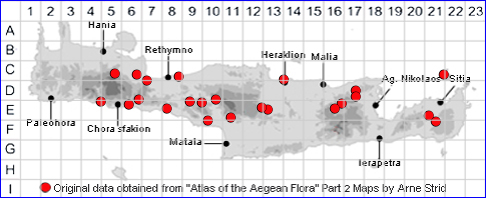
SPECIES DESCRIPTION
ILENE DICHOTOMA subsp. RACEMOSA
Family:- CARYOPHYLLACEAE/Sect. DICHOTOMAE
Common Names:- Forked catchfly
Synonyms:- Silene dichotoma
Meaning:- Silene (Gr) A name used by the Greek philosopher Theophrastus for
catchfly.
Dichotoma (Gr) Divided equally into two, split into two.
Racemosa (L) Having racemose inflorescences.
General description:- Medium to tall, erect, short-lived, hairy, perennial.
Stems:-
throughout; non-flowering shoots lacking.
Leaves:-
Flowers:-
1) White, rarely pale pink, 15-18 mm.
at the base.
8) Anthophore 1-2 mm.
Fruit:-
Key features:-
1) Plant hairy, at least in part.
2) Veins of calyx sparsely hispid.
Habitat:- Grassland, dry open shrubby vegetation, rocky slopes and cliff ledges,
occasionally roadsides and olive groves. 0-1000 m.
Distribution:- C and E Mediterranean from Crete and Greece eastwards; casual
elsewhere. Limited distribution on Crete.
Flowering time:- Apr to early Aug.
Photos by:- Steve Lenton
GLOSSARY OF TERMS USED
Acute:- Sharp, sharply pointed, the margins near the tip being almost straight.
Anthesis:- The period during which a flower is fully open and functional.
Anthophore. A stalk-like extension of the receptacle on which the pistil and corolla
are borne.
Arcuate:- Curved like a bow, bow-like.
Bract:- An organ, often small and scale-like, but sometimes leaf-like, located where
the flower-stalk joins the stem.
Carpophore:- The fruit bearing stalk A prolongation of the receptacle or floral axis
bearing the carpels or ovary.
Cilia:- Marginal hairs
Ciliate:- Fringed with hairs - generally along the margin of a leaf, petal etc.
Crispate:- Curled or ruffled.
Crispate:-Pubescent:- Curled or ruffled.and covered with fine short soft hairs,
downy.
Deflexed:- Bent sharply downwards.
Dichasial:- Pertaining to Dichasium
Dichasium-Di (pl Dichasia):- Cyme with lateral branches on both sides of the
main axis
Exserted:- Projecting beyond an enclosing organ or part.
Filament:- The stalk of a stamen, connecting the receptacle to the anther.
Glabrous:- Without hairs, hairless.
Hispid:- With stiff bristly hairs.
Inflated:- Swollen, like a bladder.
Inflorescence:- The flowering branch or branches, flowers and bracts above the
uppermost leaves on a stem.
Keel - Keeled:- A prominent longitudinal ridge like the keel of a boat.
Monochasial- Inflorescence with a terminal flower and one bracteole subtending a
lateral flower.
Obovate:- Inversely ovate, broadest towards the apex and tapering to the stalk.
Obovate--Lanceolate:- Inversely ovate or broad and rounded at the base and
tapering toward the end.
Ovate:- Broad and rounded at the base and tapering toward the end.
Ovoid:-Oblong:- Egg-shaped to rectangular.
Pedicel:- The stalk of an individual flower.
Petal:- The inner perianth segments when they clearly differ from the outer.
Petal-limb:- An enlarged upper part of the petals.
Raceme:- A spike-like inflorescence in which the individual flowers are stalked.
Racemose:- Taking the form of a raceme.
Rosette:- A circular arrangement of leaves usually sitting near the soil.
Spatulate:- Paddle-shaped, oblong with an extended basal part.
Stigma:- The receptive tip of a style to which pollen grains adhere.
Style:- The stalk that connects the stigma to the ovary.
Tubercle:- A small rounded projection or protuberance, wart-like projections.
Tuberculate:- With small, wart-like projections.
Villose, villous:- Covered with long, shaggy hairs.
